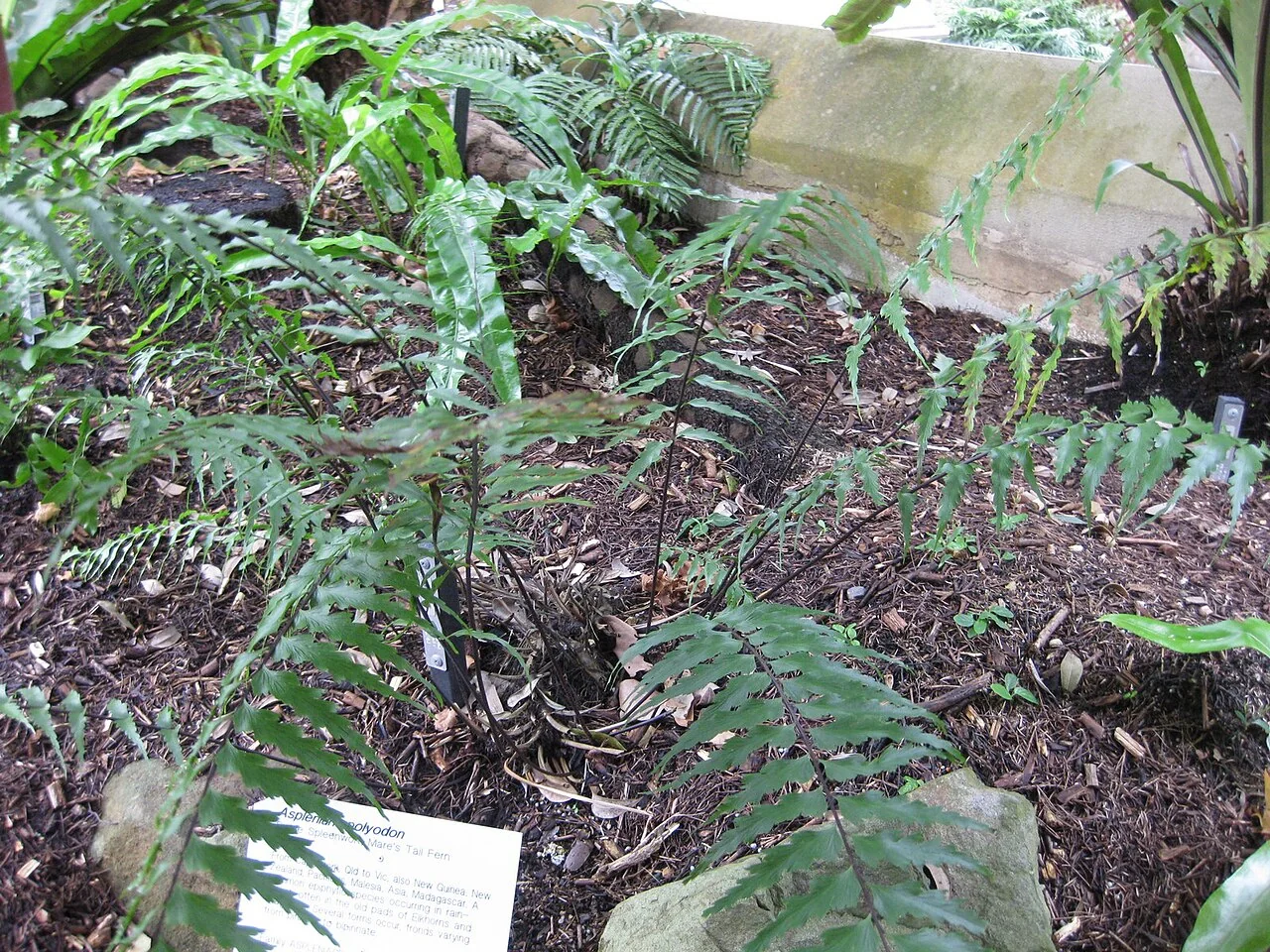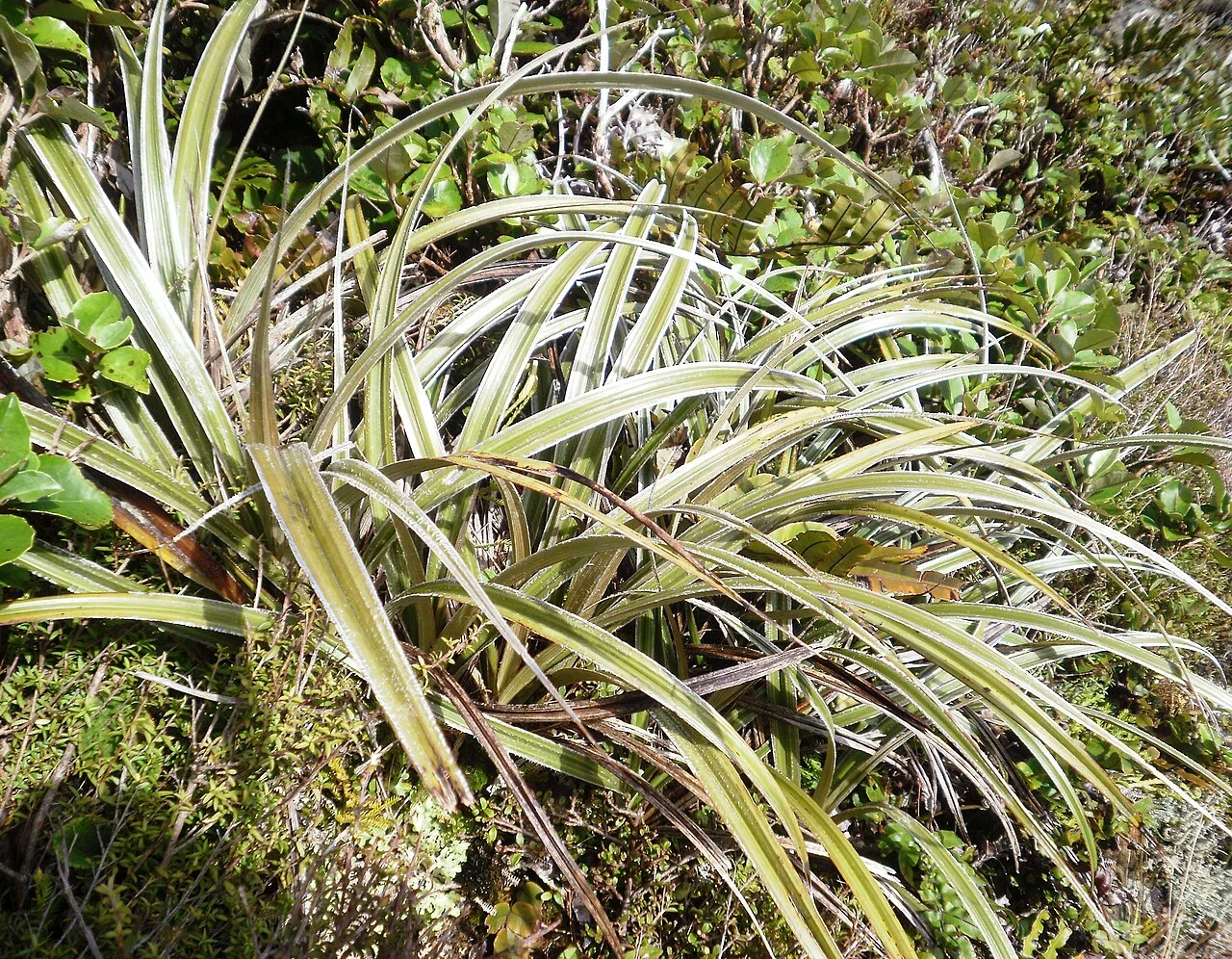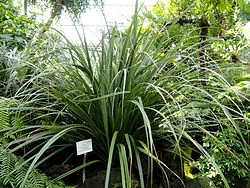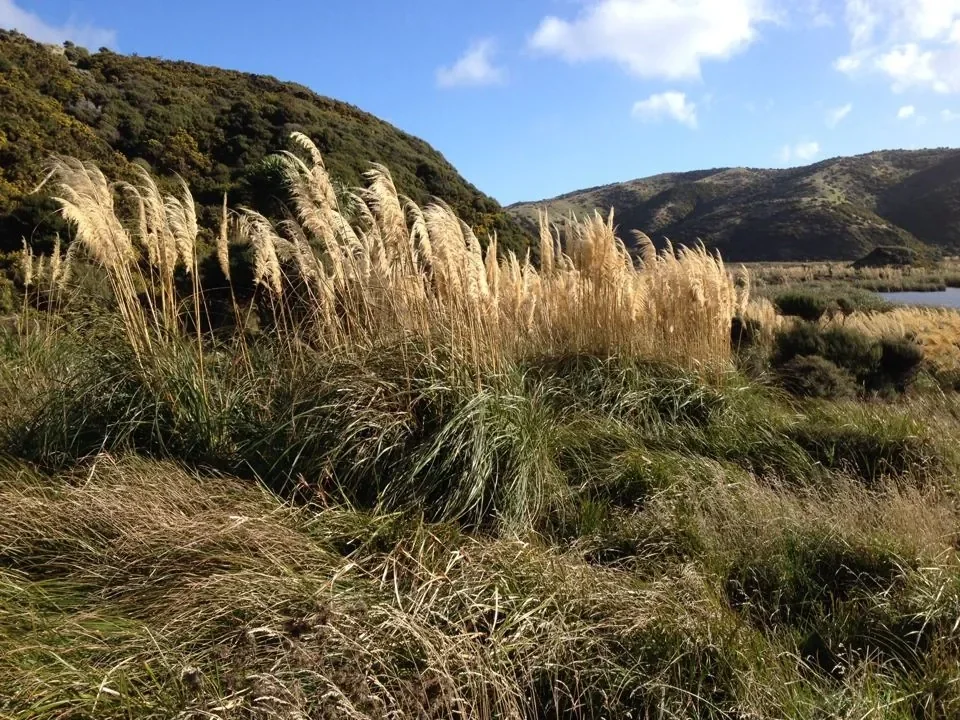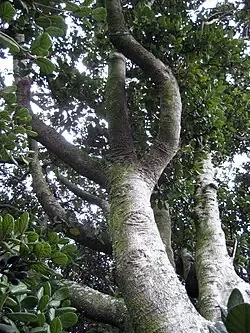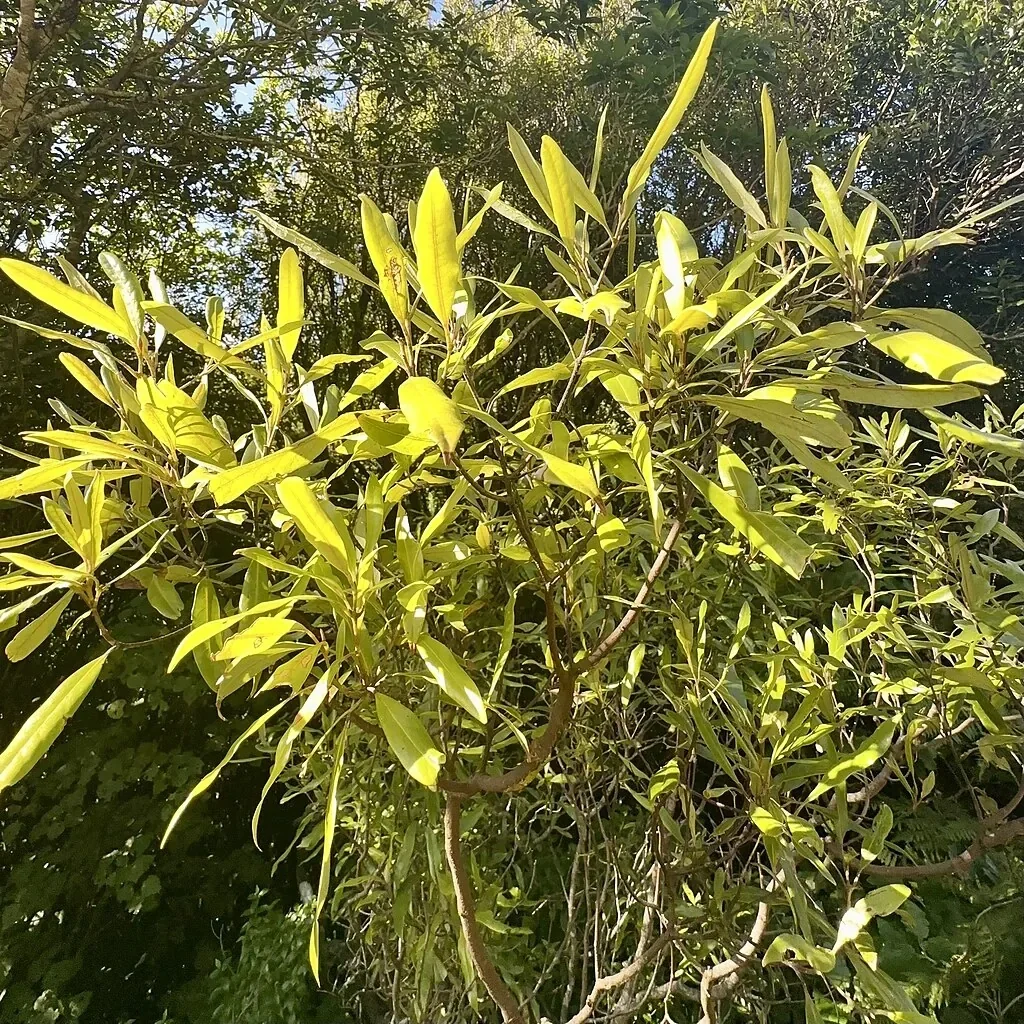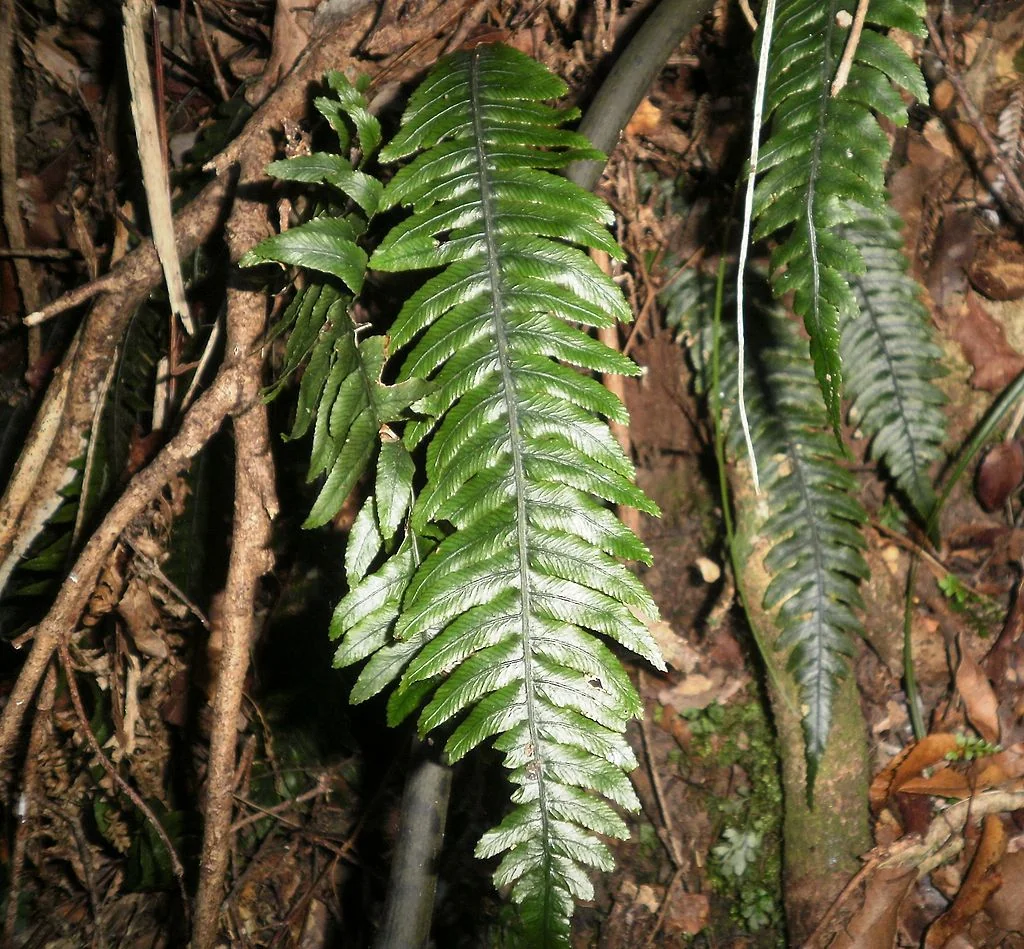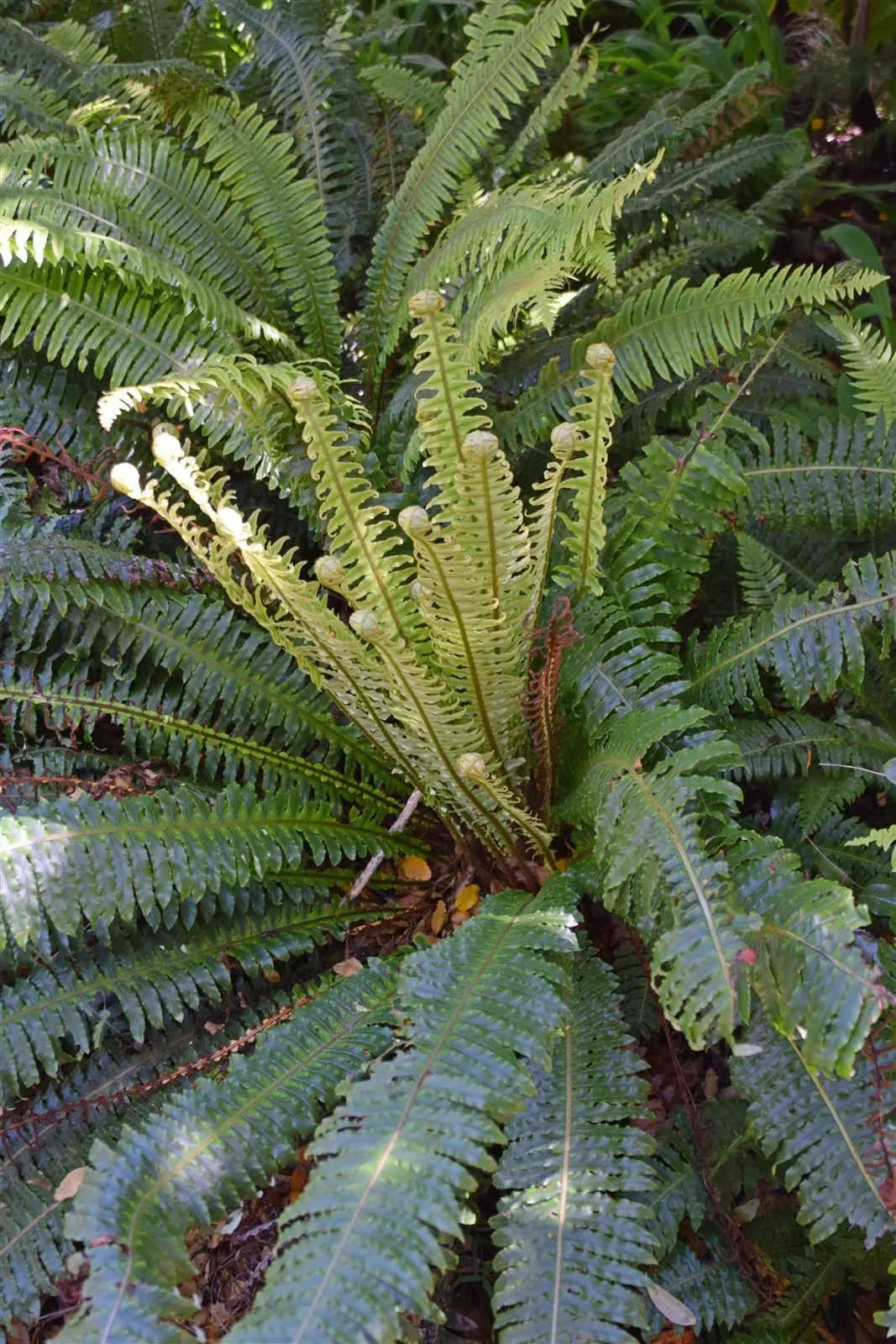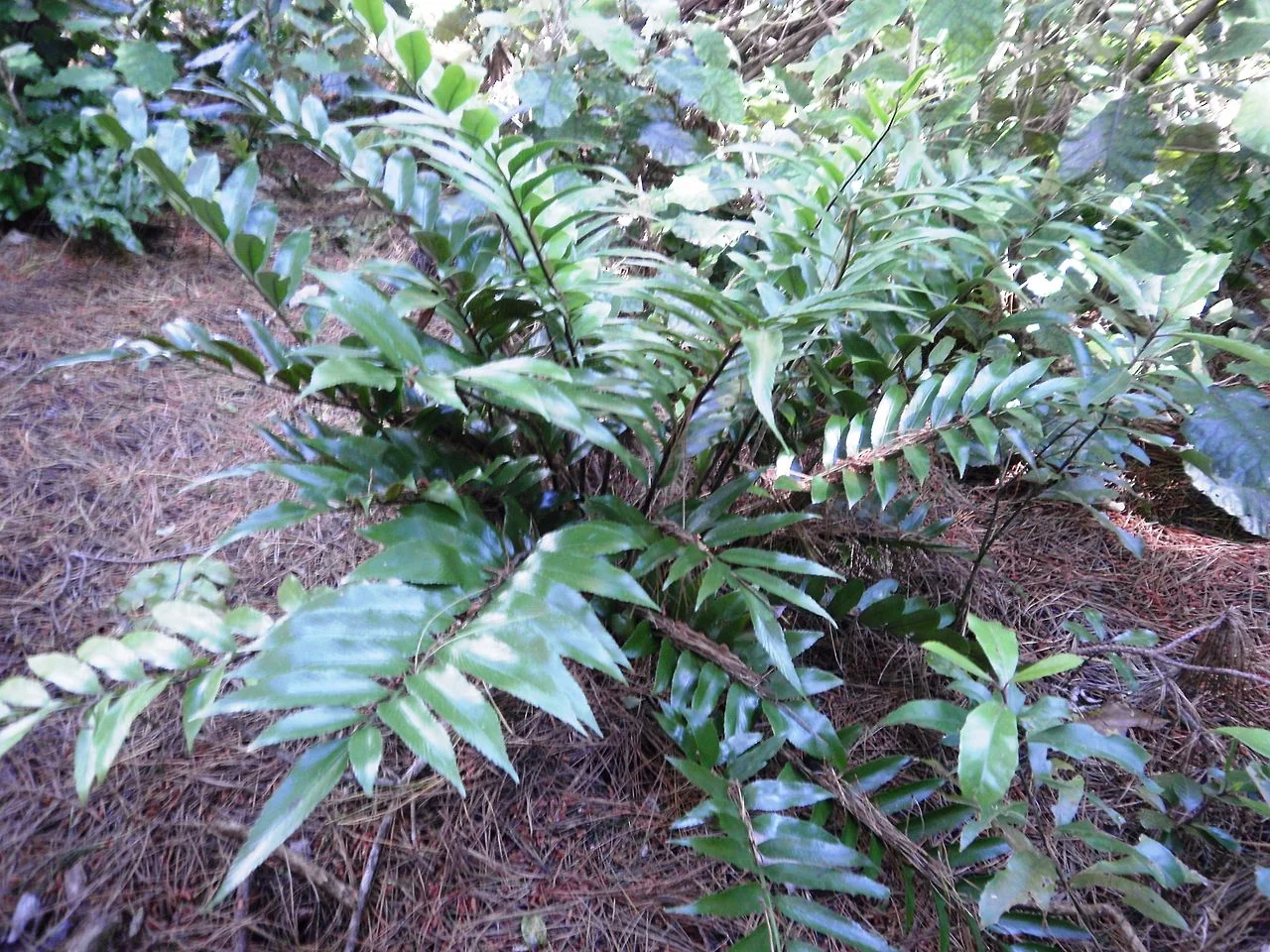
Shining Spleenwort
Asplenium oblongifolium
Introduction
Essential Information
Shining Spleenwort is a robust, evergreen fern native to New Zealand, noted for its glossy, leathery fronds and tidy clumping habit. It inhabits coastal to lowland forests, rocky banks, and shaded gullies. The dark, shining fronds form attractive fountains of foliage that tolerate salt-laden winds and dry summer spells once established, making this a dependable shade-garden fern among New Zealand-s native ferns .

Plant Description
Botanical Features
Shining Spleenwort ( Asplenium oblongifolium ) is a distinctive native fern characterized by its robust, evergreen growth habit and glossy, leathery fronds. This handsome fern forms neat clumps with arching fronds that can reach 30-100cm in height and spread to 60-120cm wide. The dark green, shining foliage provides an elegant architectural element in shaded garden areas, while its tough constitution makes it well-suited to challenging coastal and exposed positions where many other ferns struggle to thrive.
Quick Facts
Plant Specifications
| Scientific Name | Asplenium oblongifolium |
|---|---|
| Height | 0.3-1.0 m |
| Spread | 0.6-1.2 m |
| Water Needs | Moderate; prefers consistent moisture |
| Light | Partial to full shade |
| Frost Tolerance | Moderate (to approx. -5C once established) |
| Salt Tolerance | High |
| Growth Rate | Moderate |
| Lifespan | Long-lived perennial |
Climate Best Suited to
Shining Spleenwort ( Asplenium oblongifolium ) is naturally found in coastal to lowland forests throughout New Zealand. It thrives in mild, humid climates with consistent moisture and protection from extreme temperature fluctuations. Its coastal distribution indicates good tolerance for salt-laden winds and moderate temperature ranges. The species prefers areas with regular rainfall but can adapt to drier conditions once established in shaded locations.
Regional Suitability
| City | Climate Suitability |
|---|---|
| Whangārei | Ideal |
| Auckland | Ideal |
| Hamilton | Ideal |
| Tauranga | Ideal |
| Rotorua | Ideal |
| Gisborne | Ideal |
| New Plymouth | Ideal |
| Napier | Ideal |
| Whanganui | Ideal |
| Palmerston North | Ideal |
| Wellington | Ideal |
| Nelson | Ideal |
| Christchurch | Ideal |
| Dunedin | Ideal |
| Invercargill | Ideal |
Natural Habitat
Distribution and Environment
Understand the natural habitat of Shining Spleenwort ( Asplenium oblongifolium ), including its geographical distribution, preferred environmental conditions, and the types of ecosystems where it thrives. This knowledge is crucial for replicating its natural growing conditions in cultivation.
- Geographical distribution in coastal and lowland New Zealand.
- Preferred shaded, humid forest climate and soil conditions.
- Typical associated plant communities in native forests.
Plant Conservation Efforts
Conservation Status
Explore the conservation status of Shining Spleenwort ( Asplenium oblongifolium ) and the efforts being made to protect this valuable species. This section highlights the importance of conservation, current initiatives, and how individuals can contribute to its preservation for future generations.
- Conservation status and threats to coastal forest habitats.
- Current protection initiatives and habitat restoration.
- How to get involved in native fern conservation.
Growing Requirements
Soil Requirements
Shining Spleenwort thrives in fertile, humus-rich, and well-drained soil. It is essential to keep the soil consistently moist but not waterlogged. To improve the structure and water retention of heavy clay soils, amend them with organic matter like leaf mould or compost. An annual application of mulch will help keep the roots cool and moist.
Light Requirements
This fern is best suited to shady or semi-shaded locations with filtered, indirect light, which mimics its natural habitat in the forest understory. It is crucial to protect it from direct, intense sunlight, as this can cause the fronds to scorch. In cooler climates, it may tolerate some morning sun if the soil is kept moist.
Water Requirements
Regular watering is necessary, especially during dry periods, to maintain even soil moisture. While it appreciates humidity, good drainage is vital to prevent root rot. Once established in a deeply shaded and well-mulched site, it can exhibit good tolerance to drier conditions.
Planting Guide
When to Plant
The ideal time to plant Shining Spleenwort ( Asplenium oblongifolium ) is during autumn or spring. These seasons offer moderate temperatures and reliable rainfall, providing optimal conditions for root establishment before the extremes of summer heat or winter cold.
Site Selection
Choose a site with:
- Partial to full shade for best growth and frond health
- Fertile, humus-rich, well-draining soil
- Protection from strong, drying winds and direct sunlight
- Adequate space for mature spread of 0.6-1.2 m
- Good air circulation to prevent fungal issues
Planting Procedure
- Dig a hole twice as wide and the same depth as the root ball
- Amend heavy soils with compost or leaf mould to improve drainage and fertility
- Position the plant so the crown sits at soil level, not planted too deep
- Backfill with amended soil, gently firming to remove air pockets
- Create a small watering basin to help retain moisture
- Water thoroughly immediately after planting to settle the soil
- Apply a 5-10cm layer of organic mulch, keeping it away from the crown
Initial Care
Water regularly during the first growing season, especially during dry periods, to ensure proper establishment. Once established, Shining Spleenwort is quite adaptable but will benefit from consistent moisture and protection from extreme conditions.
Ecological Role
Ecosystem Functions
The ecological importance of Shining Spleenwort ( Asplenium oblongifolium ) within its native ecosystem is significant. This section explores its role in supporting biodiversity, its interactions with local wildlife, and its contribution to the overall ecological balance of its habitat.
- Contribution to forest understory diversity and structure.
- Interactions with native fauna (invertebrates, epiphytes).
- Role in ecosystem health and coastal bank stabilization.
Uses and Significance
Garden Uses
- An excellent choice for shaded borders and underplanting.
- Well-suited for coastal gardens due to its salt tolerance.
- Can be grown as an attractive container plant for patios and courtyards.
- Ideal for woodland-style plantings.
Ecological Value
As an endemic species, Asplenium oblongifolium is a key component of New Zealand's native ecosystems. It often grows on the forest floor or as an epiphyte on trees, contributing to the lush, layered structure of the bush. It provides habitat for various invertebrates and helps to maintain humidity levels within the understory, benefiting other nearby plants.
Landscaping Applications
Design Integration
Discover how Shining Spleenwort ( Asplenium oblongifolium ) can be effectively integrated into various landscaping designs. This section offers creative ideas and practical advice for using this fern to enhance the beauty and functionality of your outdoor spaces, from residential gardens to public parks.
- Design ideas for shade gardens and woodland settings.
- Best uses in coastal and container gardens.
- Combining with other native plants for aesthetic appeal.
Seasonal Care Calendar
Spring
As new fronds (croziers) emerge, apply a balanced organic fertilizer, such as blood and bone, to support healthy growth. This is also an excellent time to apply a layer of mulch to help conserve soil moisture for the warmer months ahead.
Summer
Ensure the plant receives consistent water, especially during hot and dry spells. If grown in a location with significant sun exposure, provide extra shade to prevent the fronds from scorching.
Autumn
Trim any old or damaged fronds to keep the plant looking tidy. If the plant has become too crowded, autumn is a suitable time to divide the clumps. You can also collect spores from the undersides of mature fronds for propagation.
Winter
In areas prone to severe frost, provide some protection, especially for younger plants. Ensure the soil remains well-drained to avoid waterlogging, which can be detrimental during the colder months.
When to Prune and How Much
Pruning Guidelines
Shining Spleenwort ( Asplenium oblongifolium ) requires minimal pruning to maintain its natural form and health. Pruning should focus on removing old or damaged fronds and maintaining the plant's tidy appearance.
- Remove old, yellowing, or damaged fronds at any time of year
- Cut fronds back to the base of the plant using clean, sharp scissors
- Trim in autumn to tidy up before winter dormancy
- Remove any dead material to prevent pest and disease issues
- Avoid cutting healthy green fronds as they provide energy for the plant
- Clean tools between plants to prevent disease spread
Always use clean, sharp tools for pruning to minimize the risk of disease and ensure clean cuts. The plant responds well to gentle maintenance with vigorous new growth in spring.
How to Grow Shining Spleenwort
Spores
Spore propagation is the natural reproduction method for Shining Spleenwort, utilizing the minute spores that are wind-dispersed from mature plants in coastal and lowland forest environments. This attractive and popular New Zealand native produces fertile spores in sori located on the undersides of mature fronds, offering gardeners an opportunity to grow this species from its natural reproductive cycle. The optimal timing for spore collection is during late summer to autumn when the sori have ripened from green to brown, indicating spore maturity. Monitor established plants carefully, as spore production can vary between individuals and environmental conditions. To collect spores, select healthy, mature fronds with clearly visible brown sori and cut them carefully with clean scissors. Place the cut fronds in clean paper envelopes or bags and store in a warm, dry location for several days to allow natural spore release. The released spores appear as fine, dust-like particles that should be sown immediately for optimal germination rates. Prepare a sterile growing medium using finely chopped sphagnum moss mixed with peat moss and perlite, sterilizing the mixture with boiling water and allowing it to cool completely. Sow spores thinly on the moist surface at approximately 5mm depth and cover containers with glass or clear plastic to maintain high humidity levels essential for successful germination. Maintain consistent temperatures between 20-25°C with bright, indirect light, ensuring the growing medium remains consistently moist but not waterlogged. Germination typically occurs within 4-8 weeks under optimal conditions, though some spores may take longer to develop. The initial prothallus stage gradually develops into recognizable fern sporophytes over several months. Transplant young ferns when they reach approximately 5cm in height into individual containers with a humus-rich, well-draining growing medium. This method produces plants with natural genetic variation and is particularly valuable for restoration projects or specialized fern collections.
Division
Division provides a reliable and efficient propagation method for established Shining Spleenwort clumps, taking advantage of the species' ability to spread through rhizomes and occupy larger areas over time. This method is particularly effective for gardeners who want to multiply existing plants or rejuvenate older specimens that may have developed dense, overcrowded clumps. The optimal timing for division is during autumn or early spring when the plant is entering or emerging from its dormant period, allowing divided sections to establish quickly in favorable growing conditions. Begin by carefully lifting the entire clump using a garden fork, working slowly around the perimeter to avoid damaging the delicate root system and rhizomes. Shining Spleenwort develops a network of underground rhizomes that create natural division points where new crowns have formed. Once lifted, gently shake away excess soil to expose the rhizome structure and identify these natural divisions. Use a sharp, sterilized knife to cut through connecting rhizomes, ensuring each division includes both healthy roots and at least one active growing point with visible fronds or emerging shoots. Each division can be relatively small, as this species establishes well from minimal root material provided adequate moisture and protection are maintained during establishment. Replant divisions immediately in prepared soil that replicates forest floor conditions, using a mixture of leaf mold, compost, and well-draining soil. Choose locations with partial to full shade, as this species performs best in shadier situations despite its tolerance for more open conditions. Water thoroughly after planting and maintain consistent soil moisture throughout the establishment period, typically 6-10 weeks during favorable conditions. This method is particularly valuable for creating mass plantings in shaded sites, where Shining Spleenwort's attractive appearance and adaptability make it an excellent choice for landscaping under established trees or in woodland gardens.
Container Cultivation
Container cultivation represents the most accessible approach for growing Shining Spleenwort, taking advantage of its reputation as an excellent pot plant while providing controlled growing conditions that ensure success. This method effectively bypasses the technical challenges of spore propagation while allowing gardeners to enjoy this attractive native fern regardless of their garden's natural conditions. Asplenium oblongifolium thrives in container culture due to its naturally compact growth habit and moderate moisture requirements, making it more forgiving than many other native fern species. Choose containers with excellent drainage, such as terracotta pots or specialized fern containers, as proper drainage is essential for preventing root rot in this coastal and lowland species. Use a well-draining, humus-rich growing medium that replicates forest floor conditions, combining quality potting mix with leaf mold, bark chips, and perlite in proportions that provide both moisture retention and rapid drainage. Position containers in locations that receive partial to full shade, avoiding direct sunlight that can stress the fronds, though this species is more tolerant of open conditions than many other spleenworts. The relatively slow establishment rate mentioned in cultivation notes means patience is required initially, but once established, container-grown specimens are quite resilient and low-maintenance. Maintain consistent moisture levels without allowing the growing medium to become waterlogged, and provide additional humidity during dry periods through misting or humidity trays. Be vigilant for scale insects and mealy bugs, which are common problems for all New Zealand Asplenium species in cultivation, and treat promptly with appropriate organic treatments. Regular feeding with diluted liquid fertilizer during the growing season supports healthy development, while the moderate growth rate means repotting is only needed every 2-3 years. Container cultivation also allows flexibility in positioning plants to take advantage of seasonal microclimates and provides an excellent way to showcase this species' attractive, glossy fronds in patios, courtyards, or indoor environments.
Division Care
- Ensure each division has healthy fronds and root system
- Plant divisions immediately in prepared soil
- Keep soil consistently moist until establishment
Pests and Diseases
Shining Spleenwort ( Asplenium oblongifolium ) is generally resilient but can face certain challenges in cultivation. Understanding potential issues helps maintain plant health.
Common Pests
- Slugs and Snails: Can damage new emerging fronds. Use organic baits or physical barriers for control.
- Scale Insects: May occur in dry conditions. Treat with horticultural oil or insecticidal soap.
- Aphids: Occasionally affect new growth. Remove with water spray or beneficial insects.
Common Diseases
- Root Rot: Caused by poor drainage or overwatering. Ensure adequate drainage and avoid waterlogged conditions.
- Fungal Issues: Can occur in humid, poorly ventilated conditions. Provide good air circulation.
Most established Shining Spleenwort plants are resilient enough to recover from minor pest and disease issues. Proper growing conditions and good garden hygiene prevent most problems.
Cultural Significance
Shining Spleenwort (Asplenium oblongifolium) was used in traditional Māori medicine (rongoā) for various ailments. The fronds were also used for weaving and creating decorative items.
Bonus Tip
Morning Dew Display
For the best display of Shining Spleenwort's glossy fronds, plant it where morning dew can collect on the leaves and create stunning light effects. The natural sheen of the fronds is most pronounced when they're moist, making them particularly striking in shaded courtyards or under the dappled light of larger trees.
